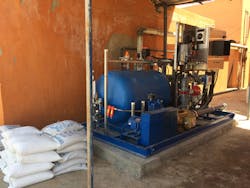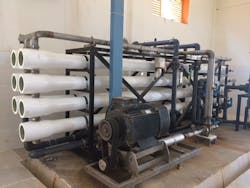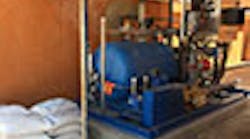Sand filtration as a water treatment strategy has been around for thousands of years, dating as far back as 2000 BC to ancient Greek and Sanskrit writings. As Alain Silverwood, technical director of Vortisand® systems at Evoqua Water Technologies, explains, recent innovations in this time-tested method are poised to make a dramatic impact on one of the fastest-growing water industry segments: desalination.
WATERWORLD: The global desalination market is seeing a surge in installed capacity around the world. What is the current state of the industry as you see it?
ALAIN SILVERWOOD: That's correct. Since 2008, we've seen around a 60% increase in installed capacity. According to recent data from the International Desalination Association and Global Water Intelligence, the current installed base is approximately 80 million cubic meters per day (m3/day) -- or 19.8 billion U.S. gallons.
WW: What seems to be driving this growth?
AS: The increase is mainly attributed to human consumption (i.e., for drinking water purposes). With the rapid increase in population growth, coupled with stressed water supplies, coastal communities are increasingly turning to the sea to meet drinking water needs. And even inland, there is a growing need to treat brackish groundwater.
Historically, large scale desalination has mainly been built in the Gulf region where there is no alternative for public water supply. But the combination of lower cost membrane desalination and increased water scarcity means that big desalination plants have been built -- or will soon come online -- outside the Gulf: the 444,000 m3/d Victoria Desalination Plant in Melbourne, Australia; the 500,000 m3/d Magtaa plant in Algeria; the 510,000 m3/d Soreq plant in Israel; the 880,000 m3/d Shoaiba 3 desalination plant in Saudi Arabia; and the 1,025,000 m3/d Ras Al Khair project in Saudi Arabia.
In fact, desalination is now practiced in 150 countries, from Australia to China and Japan, the United States, Spain and other European countries, the Middle East and North Africa.
WW: How does your technology, the Vortisand Crossflow Microsand Filter (CMF), fit into this market?
AS: It's a new sector for us, but we believe that the technology applies very well. Conventional sand filtration has been around since the Roman Empire and can still provide good performance for water purification in some less challenging applications. In fact, the Vortisand filter has been around for decades. It was acquired by a Montreal company in 1986 and today is part of Evoqua Water Technologies. In 2012, in order to stay ahead of the competition, an ambitious two-year research and development program was launched, a program that led to the innovation we see today and better application of the cross-flow combined with the microsand of the Vortisand® filter.
The CMF sits at the front of the desalination treatment train, ahead of the reverse osmosis (RO) process. Its purpose is to pretreat the water going into the RO system.
With regard to desalination, one of the main expenses is electric power. It represents about 28-50 percent of the cost. Because of the better performance offered by the CMF, we expect a reduction in energy consumption for these types of plants. Another major expense is capital recovery, accounting for about 30-44 percent of costs. Since the technology we're providing has a smaller footprint, we envision a CAPEX reduction here as well.
In addition, because we are providing such good quality water to the RO process, there will be less fouling of the membranes. This presents several ancillary benefits: reduced cleaning frequency, consumption of fewer cleaning chemicals, and ultimately a reduction in membrane replacement.
WW: You recently conducted a pilot trial in Egypt. What insights into the filter's performance were you able to gain?
AS: Yes, the pilot tested the CMF against a conventional multimedia filtration (MMF) system.
The Vortisand CMF, shown here, was pilot-tested against a conventional multimedia filtration system.
It was conducted with two side-by-side sea water RO trains sharing a common open sea intake. The results indicate that the CMF outperformed the MMF in a few key areas: silt density index (SDI) and turbidity levels (NTU). Here, the CMF was able to reduce the SDI by 80% (compared to MMF at 64%) and achieve an NTU reduction of 95% (compared to the MMF at 65%).
Conventional multimedia filtration system at the Egypt plant.
The CMF also demonstrated flux rates three to four times faster than conventional MMF, and operated in a much smaller footprint -- three times smaller, in fact.
Reverse osmosis system at the Egypt plant.
Based on the study, we believe that the CMF has great potential to significantly reduce life cycle costs for desalination plants. This is critical as water scarcity and population growth continue to drive demand for alternative drinking water supplies.
Editor's Note: For a deeper look into the results of the study demonstrating the benefits of high-efficiency cross-flow technology as a pretreatment solution in RO applications, click here to access the complete white paper that was recently presented at the International Desalination World Congress.






